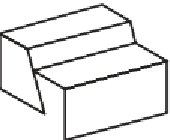Geoscience Reference
In-Depth Information
Strike-slip or
lateral fault
Reverse
fault
Normal
fault
+
+
Lateral
reverse
fault
Lateral
normal
fault
Types of faults associated with earthquake activity.
Fig. 9.8
damage over a much larger area. Weathered material
above bedrock can absorb considerable amounts of the
fault displacement, such that faulting occurring in
underlying bedrock may not be present at the Earth's
surface. Elastic strain can be relieved slowly over time
as
tectonic creep
. Such creep can be monitored and
used as a tool for earthquake prediction, a facet that
will be discussed later.
Earthquakes can be triggered by sudden loading or
deloading of the Earth's crust along most faults. The
coincidence of tropical cyclones and earthquakes has
already been noted in Chapter 3. Here the mechanism
was linked to the rapid onset of storm surges on conti-
nental shelves. The loading threat may be even more
subtle. In Japan, records over the last 1500 years
indicate that intra-plate earthquakes with magnitudes
greater than 7 are three times more likely to occur in
spring. The cause is related to snow accumulation
during winter that puts stress on reverse and strike-
slip faults. Rapid melting in spring then unloads the
crust suddenly, triggering earthquakes. As little as 1 m
equivalent depth of water may be involved in the
process.
Faulting and earthquakes can also operate via
dilatancy in crustal rocks. At depths greater than
5 km, the pressure due to the weight of overlying rock
is equal to the strength of unfractured rock. The
shearing forces bringing about sudden brittle failure
and frictional slip can never be obtained, because the
rock deforms as a
plastic
. However, the presence of
water provides a mechanism for sudden rupture by
reduction of the effective friction along any crack
boundary. If crustal rocks in the upper crust strain
without undergoing plastic deformation, they may
crack locally and expand in volume. The process is
known as
dilation
. Cracking may occur too quickly for
immediate groundwater penetration, but water will
eventually penetrate the cracks, providing lubrication
for any remaining stresses to be released. This model
has prospects for predicting earthquakes because it
invokes measurable changes in ground levels, electri-
cal conductivity and other physical factors preceding
tremors.
Add
ed water (dams and rain)
The dilatancy theory can also explain the presence of
earthquakes around reservoirs. Reservoir earthquakes
occur in both seismic and non-seismic zones, and are
unrelated to rock type or local faulting patterns.
Interest in this phenomenon started in 1935 after the
































































